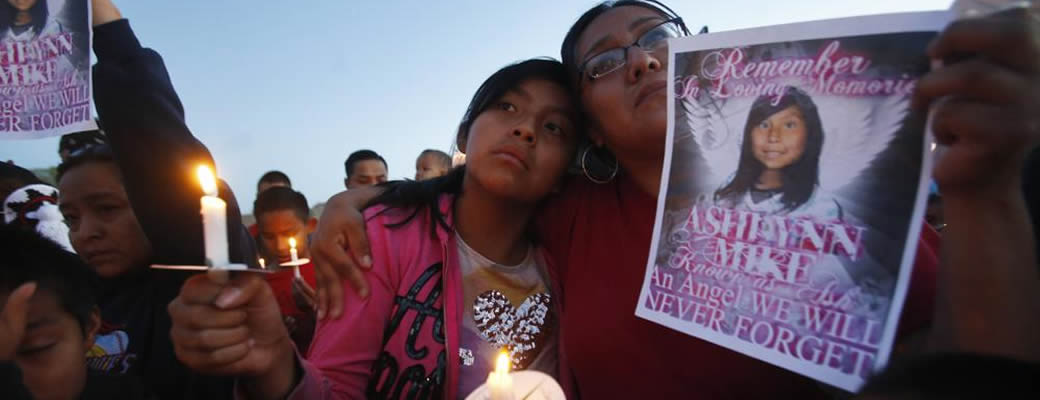Members of Congress highlight missing minority women, girls
AP
Susan Montoya Bryan
March 3, 2022
ALBUQUERQUE, N.M. (AP) — Members of a congressional panel focused on civil rights and liberties shared sobering statistics Thursday on the disproportionate number of Indigenous, Black and other minority women and girls who are being reported missing in the United States, saying more needs to be done to tackle the problem.
About 40% of the more than 250,000 women and girls reported as missing in 2020 were people of color, according to federal data gathered by the the Subcommittee on Civil Rights and Civil Liberties. Despite making up a smaller share of the overall U.S. population, committee members said Indigenous, Black and Hispanic women and girls are going missing at higher rates.
The panel’s chairman, U.S. Rep. Jamie Raskin of Maryland, called it a “crisis hiding in plain sight.” He said he was hopeful Thursday’s hearing would shine more light on a problem that has shattered countless families, exposed jurisdictional challenges for law enforcement and highlighted the importance of media attention.
The cases span the country, from South Dakota, Wyoming and Montana to Louisiana, South Carolina and New York. Of the more than 700 Indigenous people that have gone missing in Wyoming over nearly a decade, for example, less than 1 in 5 received any media coverage, Raskin noted, citing a recent report from the state.
The full scope of the problem is impossible to measure due to the lack of comprehensive and consistent data, committee members said during a hearing in Washington that included in-person and remote testimony.
Raskin also said that tribal communities often are hamstrung in their responses given jurisdictional issues, limited law enforcement resources and an inability to prosecute non-Native individuals who commit crimes on tribal land.
“The core function of government is to protect the safety and the security of the people,” Raskin said. “That’s the essence of the social contract. We have to secure and fortify the social contract for women of color all across America.”
The hearing comes as the grassroots movement among Native Americans to bring attention to the cases of their missing and slain relatives puts more pressure on state and federal officials. In New Mexico, Gov. Michelle Lujan Grisham recently signed legislation to dedicate more resources to the investigation of such cases and improve coordination among law enforcement.
Other states, including California, Oregon and Washington, have approved studies of the problem or allocated more funding for tribes.
The panel heard Thursday from Pamela Foster, the mother of 11-year-old Ashlynne Mike, who was abducted along with her brother on May 2, 2016, and left to die in a remote spot on the Navajo Nation in northwestern New Mexico. Foster’s 9-year-old son was found alive by an elderly couple along a road after he fled the kidnapper.
Foster said she had to resort to social media to get word out about the abduction. Authorities didn’t issue an Amber Alert for several hours.
“I endured the longest hours of my life — waiting, hoping and praying for my children, for their safe return,” she said.
It wasn’t enough to save her daughter, but Foster has been working ever since to ensure Ashlynne’s death was not in vain by pushing for legislation to expand the Amber Alert system to tribal communities.
Some of the panelists also talked about disparities related to how law enforcement and the media perceive victims when they are people of color.
Natalie Wilson, founder of the Black and Missing Foundation, told lawmakers that advocates understand not every missing persons case will get national attention but noted that cases involving people of color get a very small percentage of national media coverage.
“We can all name Gabby Petito, Natalee Holloway, Chandra Levy and many other white women who have gone missing. But can any of you name a person of color that has garnered national media coverage?” she asked. “We want our missing to be household names too.”
For Shawn Wilkinson, it took a month for law enforcement in Baltimore to begin looking seriously into the 2017 disappearance of his pregnant daughter, Akia Eggleston. Family members knew something was wrong when the 22-year-old Black woman failed to show up to her own baby shower.
Authorities announced an arrest in the case just weeks ago. While Eggleston’s body has not been recovered, prosecutors pointed to internet searches by the suspect that suggested her remains might be at a local landfill.
A Marine veteran who served three tours in Iraq, Wilkinson said he gave all to his country but stood broken and frustrated at not being able to get immediate help for his daughter when he needed it.
“The epidemic of missing persons of color is not a new topic but one that has been dismissed because society does not care about us,” he said. “This is a trickle effect that has come down through this country’s history. Only time has brought us to this point of actually acknowledging the disparities that exist.”
Photo credit: Jon Austria/The Daily Times via AP, File

